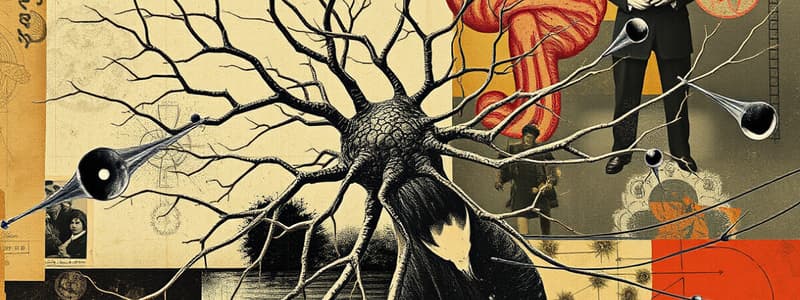Podcast
Questions and Answers
The glial cells that fight infections in the CNS are:
The glial cells that fight infections in the CNS are:
- Microglia (correct)
- Oligodendrocytes
- Astrocytes
- Satellite cells
- Ependymal cells
Neurons that convey information to the CNS are called sensory or efferent neurons.
Neurons that convey information to the CNS are called sensory or efferent neurons.
False (B)
To perform their role, neurons must have the properties of excitability, secretion, and:
To perform their role, neurons must have the properties of excitability, secretion, and:
- Stretchiness
- Extensibility
- Contractility
- Elasticity
- Conductivity (correct)
Neurons receive incoming signals by way of specialized extensions of the cell called:
Neurons receive incoming signals by way of specialized extensions of the cell called:
In the CNS myelin is produced by glial cells called Schwann cells.
In the CNS myelin is produced by glial cells called Schwann cells.
The absolute refractory period is a period of time in which a neuron is producing an action potential and cannot respond to another stimulus of any strength.
The absolute refractory period is a period of time in which a neuron is producing an action potential and cannot respond to another stimulus of any strength.
A myelinated nerve fiber can produce action potentials only in specialized regions called nodes of Ranvier.
A myelinated nerve fiber can produce action potentials only in specialized regions called nodes of Ranvier.
Saltatory conduction occurs only:
Saltatory conduction occurs only:
The highest density of voltage-gated ion channels is found on the ____ of a myelinated neuron:
The highest density of voltage-gated ion channels is found on the ____ of a myelinated neuron:
Some neurotransmitters can be either excitatory or inhibitory depending on the type of:
Some neurotransmitters can be either excitatory or inhibitory depending on the type of:
An inhibitory postsynaptic potential is ____ of the postsynaptic neuron:
An inhibitory postsynaptic potential is ____ of the postsynaptic neuron:
This is NOT a part of the peripheral nervous system:
This is NOT a part of the peripheral nervous system:
This portion of the motor division of the nervous system conducts action potentials from the central nervous system to skeletal muscle fibers:
This portion of the motor division of the nervous system conducts action potentials from the central nervous system to skeletal muscle fibers:
These cells conduct action potentials from one neuron to another within the CNS:
These cells conduct action potentials from one neuron to another within the CNS:
These cell types produce and help circulate cerebrospinal fluid:
These cell types produce and help circulate cerebrospinal fluid:
These statements about unipolar neurons are all true except:
These statements about unipolar neurons are all true except:
This statement best describes the myelin sheath:
This statement best describes the myelin sheath:
Compared to the outside of the resting cell membrane, the inside surface of the membrane is this:
Compared to the outside of the resting cell membrane, the inside surface of the membrane is this:
Because of the sodium-potassium pump, there are:
Because of the sodium-potassium pump, there are:
During saltatory conduction action potentials jump from this:
During saltatory conduction action potentials jump from this:
This best describes the refractory period:
This best describes the refractory period:
Flashcards are hidden until you start studying
Study Notes
Neurons and Glial Cells
- Microglia are the glial cells responsible for fighting infections in the central nervous system (CNS).
- Sensory neurons convey information to the CNS, while efferent neurons carry signals away from it.
- Neurons must exhibit excitability, secretion, and conductivity to perform their functions.
Neuron Structure and Function
- Dendrites are specialized extensions that receive incoming signals to a neuron.
- Myelin in the CNS is produced by oligodendrocytes, not Schwann cells. Schwann cells are associated with the peripheral nervous system (PNS).
- The absolute refractory period occurs when a neuron is generating an action potential and cannot respond to any stimulus.
Action Potentials and Conduction
- Myelinated nerve fibers produce action potentials exclusively at the nodes of Ranvier.
- Saltatory conduction occurs in myelinated fibers, allowing faster transmission of action potentials from one node of Ranvier to the next.
- The highest density of voltage-gated ion channels is located at the nodes of Ranvier.
Neurotransmitters and Synapses
- Some neurotransmitters have dual roles, acting as either excitatory or inhibitory based on the receptors present on the postsynaptic cell.
- An inhibitory postsynaptic potential results in hyperpolarization of the postsynaptic neuron, making it less likely to fire.
Nervous System Divisions
- The peripheral nervous system excludes the spinal cord, which is part of the central nervous system.
- The somatic division of the motor nervous system carries action potentials from the CNS to skeletal muscles.
Neuron Types and Functions
- Interneurons conduct action potentials between neurons within the CNS.
- Ependymal cells produce and help circulate cerebrospinal fluid.
- Unipolar neurons, mostly sensory, have a single process and are primarily located in regions such as the spinal cord, not typically in the eye or nasal cavity.
Myelin and Cell Membrane Properties
- The myelin sheath, made of Schwann cells, covers axons, providing insulation and facilitating faster action potential conduction.
- The interior of a resting cell membrane is negatively charged compared to the outside.
- The sodium-potassium pump maintains a higher concentration of K+ ions inside the cell relative to Na+ ions outside.
Refractory Periods
- The refractory period limits the number of action potentials produced over time and prevents immediate successive action potentials at the same membrane location.
Studying That Suits You
Use AI to generate personalized quizzes and flashcards to suit your learning preferences.




